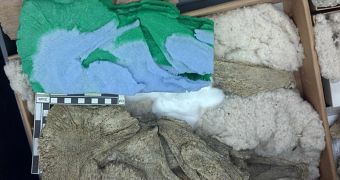A group of researchers at the University of Oregon, in the United States, are currently working on creating a 3D-printed replica of a very rare saber-toothed salmon fossil, which is much too friable to be handled during research. This effort could mark the beginning of a new trend among paleontologists.
A 3D printer works by melting plastic or another material, and then using a nozzle to deposit it on a construction surface, layer by layer. Depending on the complexity of the item being built, it can take anywhere from several minutes to several hours to build an object from scratch, based solely on a computer model of that item.
During the UO experiments, it took 70 hours for paleontologist Edward Davis and librarian Dean Walton to construct one of four pieces that will make up the final fossil replica. The printout is part of the former creature's lower jaw. The other three pieces will be built over the upcoming weeks.
Since there was no computer model for the saber-toothed salmon, the team had to develop the model used by their 3D printer from computer tomography (CT) images of the actual fossil. The first piece in their replica finished construction on December 20, 2013.
The ancient fish being reconstructed at UO boasted a length of 1.8 to 2 meters (6 to 7 feet), and lived in the Pacific Northwest around 5 million years ago. Its fossilized remains were discovered near Madras, Oregon, in 1964, and then made their way to the university's Museum of Natural and Cultural History.
“After each piece has printed, we’ll glue the pieces together, and then use them to form a cast so that additional replicas can be made,” Davis explains. The printer the team is using was purchased for the UO Science Library in November 2013.
“We couldn’t pull a cast from the actual fossil specimen because it’s so fragile, but now we have a way to do that – and to increase access to this striking animal by researchers, students and the public,” the researcher goes on to add.
The finished saber-toothed salmon fossil replica will be displayed during an upcoming natural history exhibit called “Explore Oregon,” which will be inaugurated over the next few months. The realistic model will allow visitors to interact directly with the ancient creature, and see it close-up.

 14 DAY TRIAL //
14 DAY TRIAL //